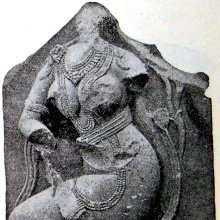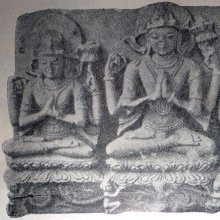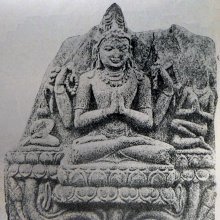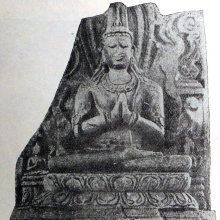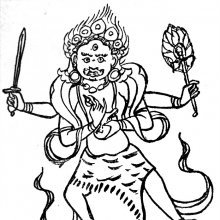Mahavidya, Mahāvidyā, Maha-vidya: 18 definitions
Introduction:
Mahavidya means something in Buddhism, Pali, Hinduism, Sanskrit. If you want to know the exact meaning, history, etymology or English translation of this term then check out the descriptions on this page. Add your comment or reference to a book if you want to contribute to this summary article.
Images (photo gallery)
(+2 more images available)
In Hinduism
Vaishnavism (Vaishava dharma)
Source: Wisdomlib Libary: VaishnavismMahāvidyā (महाविद्या)—A holy place on the bank of the Yamunā which Śrī Caitanya Mahāprabhu visited. (Śrī Caitanya Caritāmṛta, Madhya–17.191)

Vaishnava (वैष्णव, vaiṣṇava) or vaishnavism (vaiṣṇavism) represents a tradition of Hinduism worshipping Vishnu as the supreme Lord. Similar to the Shaktism and Shaivism traditions, Vaishnavism also developed as an individual movement, famous for its exposition of the dashavatara (‘ten avatars of Vishnu’).
Shaktism (Shakta philosophy)
Source: Wisdom Library: Śāktism1) Mahāvidyā (महाविद्या, “Great Knowledge”):—One of the names of Mahālakṣmī (rajas-form of Mahādevī). Mahālakṣmī is one of the three primary forms of Devī. Not to be confused with Lakṣmī, she is a more powerful cosmic aspect (vyaṣṭi) of Devi and represents the guṇa (universal energy) named sattva. Also see the Devī Māhātmya, a Sanskrit work from the 5th century, incorporated into the Mārkaṇḍeya-Purāṇa.
2) Mahāvidyā (महाविद्या, “transcendent knowledge”):—One of the names of Sarasvatī, the Hindu goddess of speech, eloquence and all forms of knowledge.
Source: Google Books: ManthanabhairavatantramMahāvidyā (महाविद्या) (or Uttamā) and Vidyeśvara refers to the pair of Goddess and God appearing in the sixteenth Kalpa (aeon), according to the Kularatnoddyota.—Chapter nine of the Kularatnoddyota opens with the goddess asking how the Kula tradition (kulāmnāya) will be worshipped along with its mantras and Vidyās and who will bring it down (avatāraka) into the world in the various cosmic aeons (kalpa). After explaining that it is brought down into the world by incarnations or aspects of both the god and the goddess (aṃśamātra), the god goes on to list the names of these aspects—a goddess and her consort [i.e., Mahāvidyā—Vidyeśvara]—in nineteen aeons (kalpa), many of which we recognize from the earlier version in the Tantrasadbhāva.—(cf. Jayadrathayāmala-tantra of the Kāpālikas).

Shakta (शाक्त, śākta) or Shaktism (śāktism) represents a tradition of Hinduism where the Goddess (Devi) is revered and worshipped. Shakta literature includes a range of scriptures, including various Agamas and Tantras, although its roots may be traced back to the Vedas.
Purana and Itihasa (epic history)
Source: Cologne Digital Sanskrit Dictionaries: The Purana IndexMahāvidyā (महाविद्या).—A name of Lalitā;1 symbolical of Devī.2

The Purana (पुराण, purāṇas) refers to Sanskrit literature preserving ancient India’s vast cultural history, including historical legends, religious ceremonies, various arts and sciences. The eighteen mahapuranas total over 400,000 shlokas (metrical couplets) and date to at least several centuries BCE.
Shaivism (Shaiva philosophy)
Source: Shodhganga: Iconographical representations of ŚivaMahāvidyā (महाविद्या) or Mahāvidyāgama refers to one of upāgamas (supplementary scriptures) of the Bimbāgama which is one of the twenty-eight Siddhāntāgama: a classification of the Śaiva division of Śaivāgamas. The Śaivāgamas represent the wisdom that has come down from lord Śiva, received by Pārvatī and accepted by Viṣṇu. The purpose of revealing upāgamas (e.g., Mahāvidyā Āgama) is to explain more elaborately than that of mūlāgamas (e.g., Bimba-āgama) and to include any new idea if not dealt in mūlāgamas.

Shaiva (शैव, śaiva) or Shaivism (śaivism) represents a tradition of Hinduism worshiping Shiva as the supreme being. Closely related to Shaktism, Shaiva literature includes a range of scriptures, including Tantras, while the root of this tradition may be traced back to the ancient Vedas.
General definition (in Hinduism)
Source: Oxford Index: HinduismMahāvidyas: A name given to a group of ten transformations, or personifications, of Devī in the Śākta Tantric literature, consisting, typically, of: Kālī, Tārā, Ṣoḍaśī, Bhuvaneśvarī, Bhairavī, Chinnamastā, Dhūmāvatī, Bagalā, Mātaṅgī, and Kamalā.
Source: WikiPedia: HinduismMahavidyas (Great Wisdoms) or Dasha-Mahavidyas are a group of ten aspects of the Divine Mother Durga or Kali herself or Devi in Hinduism. The 10 Mahavidyas are Wisdom Goddesses, who represent a spectrum of feminine divinity, from horrific goddesses at one end, to the gentle at the other.
The name Mahavidyas comes from the Sanskrit roots, with maha meaning 'great' and vidya meaning, 'revelation, manifestation, knowledge, or wisdom.
Shaktas believe, "the one Truth is sensed in ten different facets; the Divine Mother is adored and approached as ten cosmic personalities," the Dasa-Mahavidya ("ten-Mahavidyas"). The Mahavidyas are considered Tantric in nature, and are usually identified as:
- Kali – The ultimate form of Brahman, "Devourer of Time" (Supreme Deity of Kalikula systems)
- Tara – The Goddess as Guide and Protector, or Who Saves.Who offers the ultimate knowledge which gives salvation (also known as Neel Saraswati).
- Tripura Sundari (Shodashi) – The Goddess Who is "Beautiful in the Three Worlds" (Supreme Deity of Srikula systems); the "Tantric Parvati" or the "Moksha Mukta".
- Bhuvaneshvari – The Goddess as World Mother, or Whose Body is the Cosmos
- Bhairavi – The Fierce Goddess
- Chhinnamasta – The self-decapitated Goddess
- Dhumavati – The Widow Goddess,or the Goddess of death.
- Bagalamukhi – The Goddess Who Paralyzes Enemies
- Matangi – the Prime Minister of Lalita (in Srikula systems)
- Kamala – The Lotus Goddess; the "Tantric Lakshmi"
The ten Mahāvidyās –
- Kālī,
- Tarā,
- Ṣodaśī,
- Bhuvaneśvarī,
- Bhairavī,
- Cinnamastā,
- Dhūmāvātī,
- Bagalā,
- Mataṅgī
- and Kamalā
– of which the first listed is always is Kālī: the other nine are but her forms.
Source: Kamakoti: Angavidya Krama for Dasha MahavidyaThe Mahāvidyās are popularly ten in number:
- Kālī
- Tārā
- Tripurasundarī
- Bhuvaneśvarī
- Chinnamastā
- Tripurabhairavī
- Bagalāmukhī
- Mātaṅgī
- Dhūmāvatī
- Kamalātmikā
An alternate lists consists of thirteen Mahāvidyās:
- Chaṇḍayogīśvarī
- Laghuśyāmā
- Tripuṭā
In the context of Srividya, sixteen Mahāvidyās are listed (the first ten are identical):
- Vanadurgā
- Shūlinī
- Ashvārūḍhā
- Trilokyavijayā
- Mahāvārāhī
- Annapūrṇā
In the Tāntrika literature, the Mahāvidyās are usually enumerated as ten. But the number is sometimes increased by three and sometimes by six. The Muṇḍamālā-tantra names the ten Mahāvidyās thus:
- Kālī
- Tārā
- ṣoḍaśī
- Bhuvaneśvarī
- Bhairavī
- Chinnamastā
- Dhūmāvatī
- Bagalā
- Mātaṅgī
- Kamalā
The list of the Muṇḍamālā-tantra being taken as standard, the three and six additional names which occur in Sammohana Tantra are:
- Caṇḍeśvarī, Laghu śyāmā and Tripuṭā, and
- Vanadurgā, śūlinī, Aśvārūḍhā, Trailokyavijayā, Vārāhī and Annapūrṇā.
There appear to be slight differences of opinion in the various Tantras in regard to the names of the Bhairavas of these Mahāvidyās. These names, as given in the Toḍala-tantra, are:
- Mahākāla
- Akṣobhya
- Śiva
- Tryambaka
- Dakṣiṇāmūrti
- Kabandha
- Kālabhairava (Ghora) *
- Ekavaktra (Mahārudra)
- Mātaṅga (dakṣiṇāmūrti)
- Viṣṇu (Sadāśiva)
*=According to the Śaktisaṅgama-tantra.
In Buddhism
Tibetan Buddhism (Vajrayana or tantric Buddhism)
Source: Wisdom Library: Tibetan BuddhismMahāvidyā (महाविद्या) refers to a group of deities summoned by the Yamāntaka-mantra and mentioned as attending the teachings in the 6th century Mañjuśrīmūlakalpa: one of the largest Kriyā Tantras devoted to Mañjuśrī (the Bodhisattva of wisdom) representing an encyclopedia of knowledge primarily concerned with ritualistic elements in Buddhism. The teachings in this text originate from Mañjuśrī and were taught to and by Buddha Śākyamuni in the presence of a large audience (including Mahāvidyā).

Tibetan Buddhism includes schools such as Nyingma, Kadampa, Kagyu and Gelug. Their primary canon of literature is divided in two broad categories: The Kangyur, which consists of Buddha’s words, and the Tengyur, which includes commentaries from various sources. Esotericism and tantra techniques (vajrayāna) are collected indepently.
Mahayana (major branch of Buddhism)
Source: De Gruyter: A Buddhist Ritual Manual on AgricultureMahāvidyā (महाविद्या) refers to a “great spell”, according to the Vajratuṇḍasamayakalparāja, an ancient Buddhist ritual manual on agriculture from the 5th-century (or earlier), containing various instructions for the Sangha to provide agriculture-related services to laypeople including rain-making, weather control and crop protection.—Accordingly,“Then the Bhagavān praised the great Garuḍa Lord, Brahmā, Viṣṇu and Maheśvara, ‘Well done, well done, O Great Brahmā, well spoken is this speech. A great spell (mahāvidyā) is uttered. [...]’”.

Mahayana (महायान, mahāyāna) is a major branch of Buddhism focusing on the path of a Bodhisattva (spiritual aspirants/ enlightened beings). Extant literature is vast and primarely composed in the Sanskrit language. There are many sūtras of which some of the earliest are the various Prajñāpāramitā sūtras.
Languages of India and abroad
Sanskrit dictionary
Source: DDSA: The practical Sanskrit-English dictionaryMahāvidyā (महाविद्या).—the great lores; काली तारा महाविद्या षोडशी भुवनेश्वरी । भैरवी छिन्नमस्ता च विद्या धूमवती तथा । बगला सिद्धविद्या च मातङ्गी कमला- त्मिका । एता दश महाविद्याः (kālī tārā mahāvidyā ṣoḍaśī bhuvaneśvarī | bhairavī chinnamastā ca vidyā dhūmavatī tathā | bagalā siddhavidyā ca mātaṅgī kamalā- tmikā | etā daśa mahāvidyāḥ) ... ()||
Mahāvidyā is a Sanskrit compound consisting of the terms mahā and vidyā (विद्या).
Source: Cologne Digital Sanskrit Dictionaries: Shabda-Sagara Sanskrit-English DictionaryMahāvidyā (महाविद्या).—f.
(-dyā) The name of the following ten goddess:— “kālī tārā mahāvidyā ṣoḍaśī bhuvaneśvarī . bhairavī chinnamastā ca vidyā dhūmāvatī tathā . vagalā siddhavidyā ca mātaṅgī kamalātmikā ..”
Source: Cologne Digital Sanskrit Dictionaries: Aufrecht Catalogus Catalogorum1) Mahāvidyā (महाविद्या) as mentioned in Aufrecht’s Catalogus Catalogorum:—[tantric] Oppert. 6770. 7486. Ii, 1789.
—[commentary] I, 6973.
2) Mahāvidyā (महाविद्या):—[tantric] Gov. Or. Libr. Madras 67.
3) Mahāvidyā (महाविद्या):—[tantric] Cs 5, 93.
Source: Cologne Digital Sanskrit Dictionaries: Monier-Williams Sanskrit-English Dictionary1) Mahāvidyā (महाविद्या):—[=mahā-vidyā] [from mahā > mah] f. a gr° or exalted science, [Monier-Williams’ Sanskrit-English Dictionary]
2) [v.s. ...] Name of Lakṣmī, [Viṣṇu-purāṇa] (= viśva-rūpopāsanā [commentator or commentary])
3) [v.s. ...] of Durgā, [Mārkaṇḍeya-purāṇa]
4) [v.s. ...] of a Mantra, [Catalogue(s)]
5) [v.s. ...] [plural] of a class of personifications of the Śakti or female energy of Śiva (10 in number), [Religious Thought and Life in India 187]
[Sanskrit to German]
Sanskrit, also spelled संस्कृतम् (saṃskṛtam), is an ancient language of India commonly seen as the grandmother of the Indo-European language family (even English!). Closely allied with Prakrit and Pali, Sanskrit is more exhaustive in both grammar and terms and has the most extensive collection of literature in the world, greatly surpassing its sister-languages Greek and Latin.
See also (Relevant definitions)
Starts with: Mahavidyadipakalpa, Mahavidyalaya, Mahavidyamahimnah stotram, Mahavidyaprakarana, Mahavidyaprayoga, Mahavidyasaracandodaya, Mahavidyasaracandrodaya, Mahavidyastava, Mahavidyastotra, Mahavidyavidambana, Mahavidyavivarana.
Ends with: Dasha Mahavidya, Dashamahavidya, Vasundharamahavidya.
Full-text (+57): Shodashin, Tara, Dashamahavidya, Siddhavidya, Dasha Mahavidya, Tripurasundari, Dhumavati, Kamala, Mahavidyastava, Mahavidyastotra, Mahavidyaprayoga, Mahavidyaprakarana, Mahavidyasaracandrodaya, Mahavidyadipakalpa, Bagalamukhi, Kamalatmika, Padamala, Chinnamasta, Bhuvaneshvari, Mahavidyeshvari.
Relevant text
Search found 31 books and stories containing Mahavidya, Maha-vidya, Mahā-vidyā, Mahāvidyā; (plurals include: Mahavidyas, vidyas, vidyās, Mahāvidyās). You can also click to the full overview containing English textual excerpts. Below are direct links for the most relevant articles:
Diaspora of Bhuta (Daiva) worshipping cult—India and Indonesia (by Shilpa V. Sonawane)
Part 1.10 - Dhumavati—Das Mahavidya and form of Adi Parashakti < [Chapter 4 - Inter-Disciplinary Analysis]
Part 6.5 - Tantric Deities (Shaktism) < [Chapter 4 - Inter-Disciplinary Analysis]
A History of Indian Philosophy Volume 2 (by Surendranath Dasgupta)
Part 15 - Mahā-vidyā and the Development of Logical Formalism < [Chapter XI - The Śaṅkara School of Vedānta (continued)]
Part 11 - Padmapāda (a.d. 820) < [Chapter XI - The Śaṅkara School of Vedānta (continued)]
Part 4 - Teachers and Pupils in Vedānta < [Chapter XI - The Śaṅkara School of Vedānta (continued)]
The Indian Buddhist Iconography (by Benoytosh Bhattachacharyya)
Figure 94-98 - (Avalokiteśvara): Ṣaḍakṣarī-Lokeśvara
Figure 135-136 - Emanations of Akṣobhya: Mahācīna Tārā (Ugratārā)
The Devi Bhagavata Purana (by Swami Vijñanananda)
Chapter 11 - On the description of the enclosure walls built of Padmarāga maṇi, etc., of the Maṇi Dvīpa < [Book 12]
Chapter 12 - On the description of Maṇi Dvīpa < [Book 12]
Garga Samhita (English) (by Danavir Goswami)
Verse 4.19.105 < [Chapter 19 - A Thousand Names of Srī Yamunā]
Sripura (Archaeological Survey) (by Bikash Chandra Pradhan)
Scultures of Sadaksari-Lokesvara < [Chapter 3 - Sculptural Programme]
Scultures of Buddhist Goddesses (1): Tara < [Chapter 3 - Sculptural Programme]
Related products
